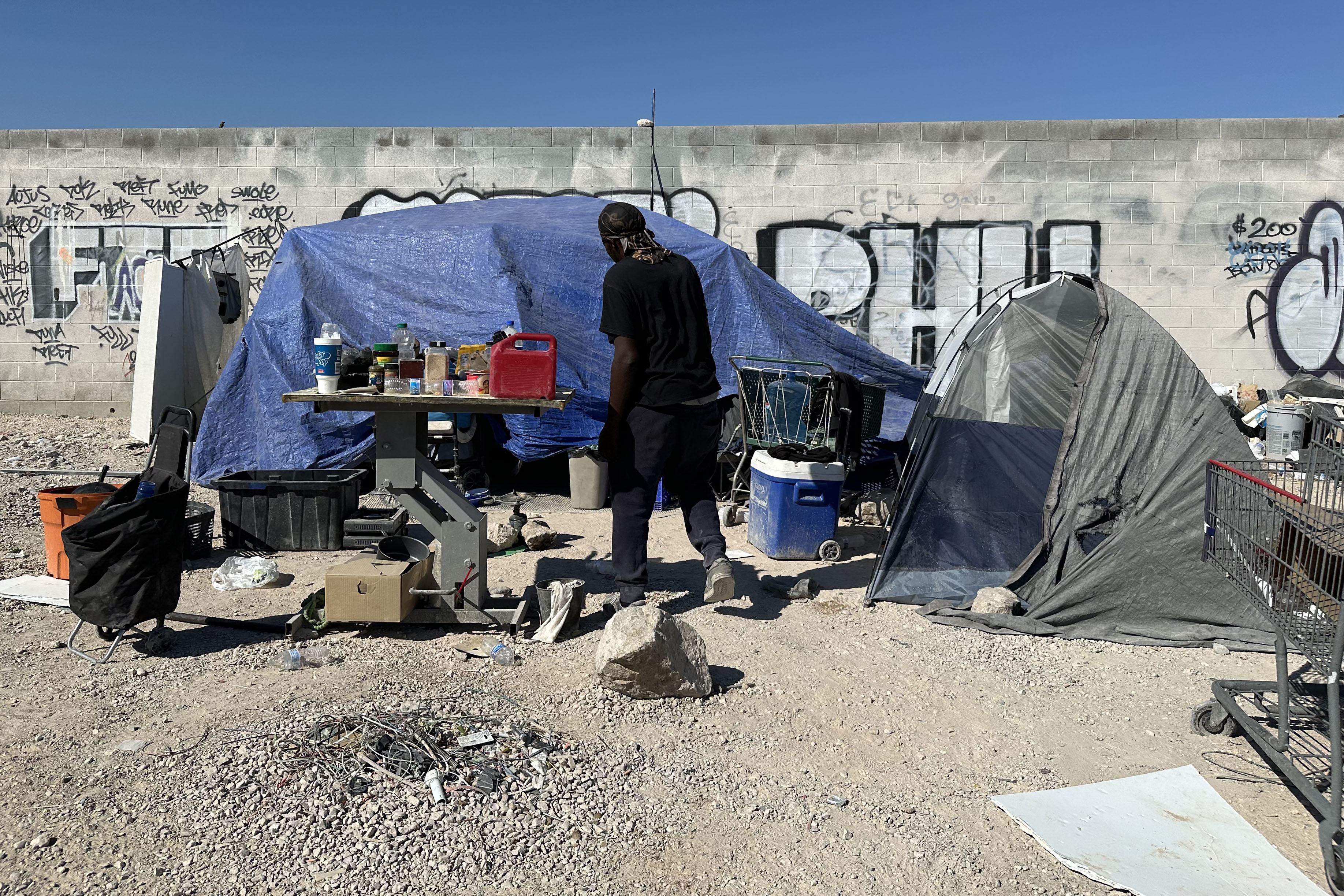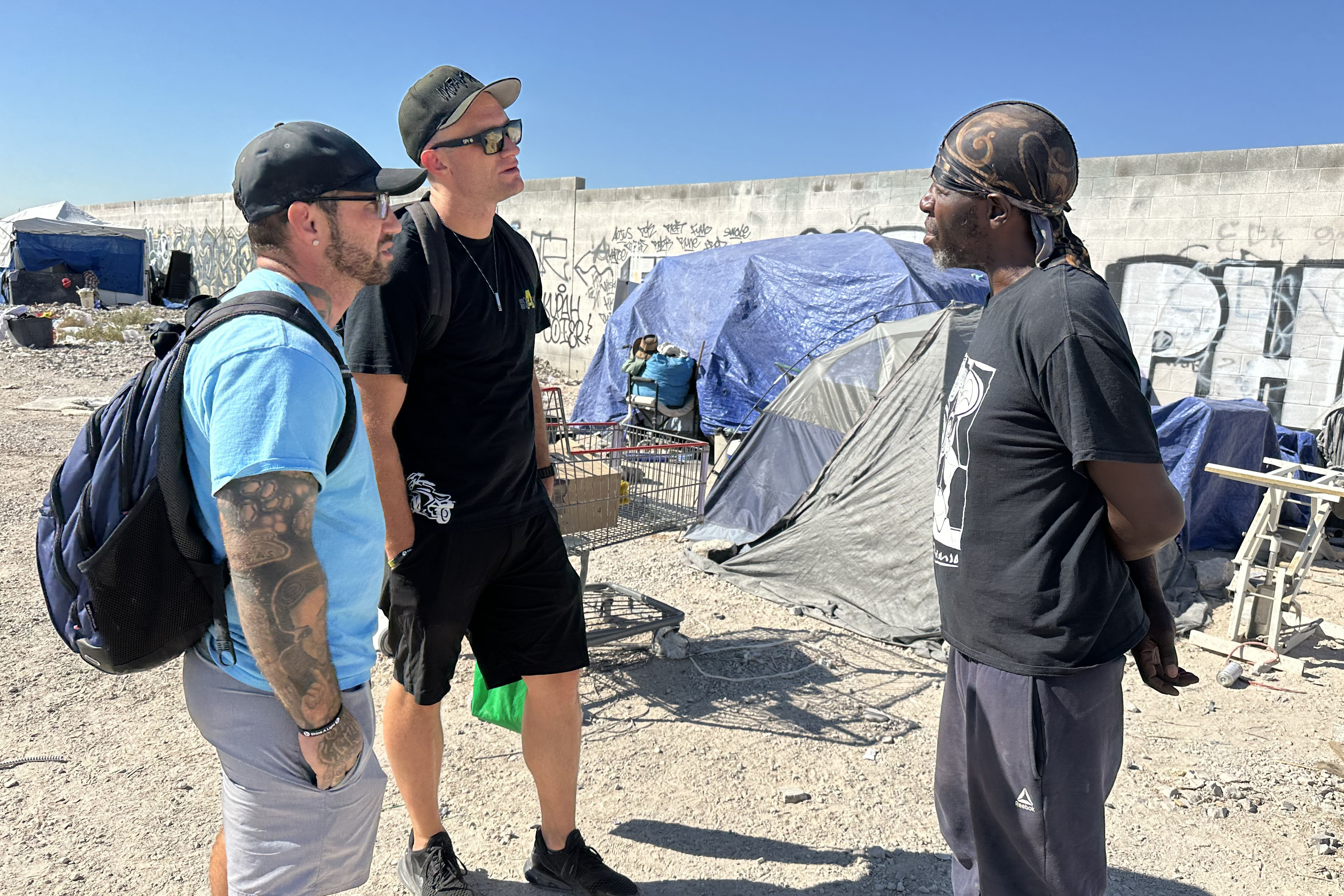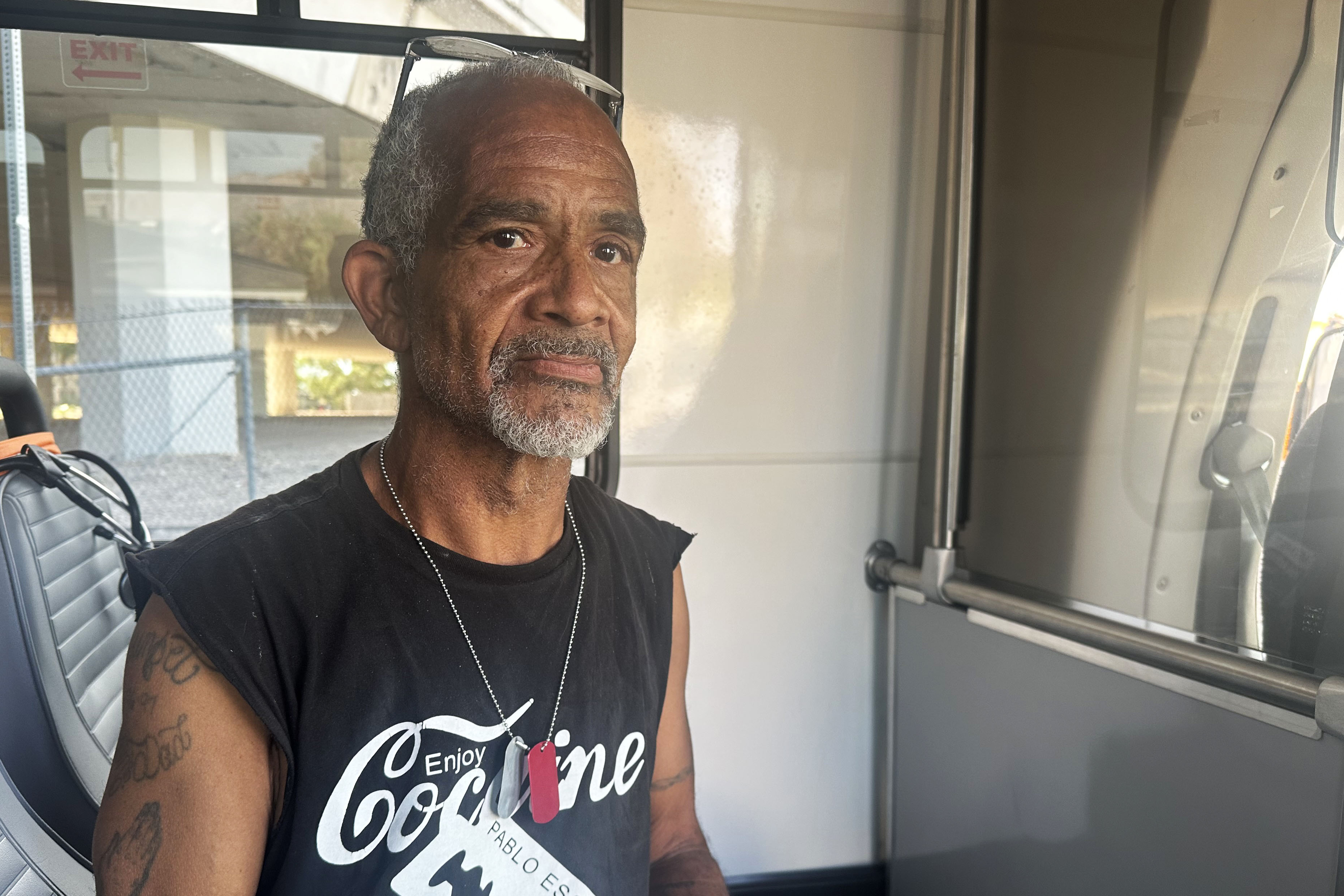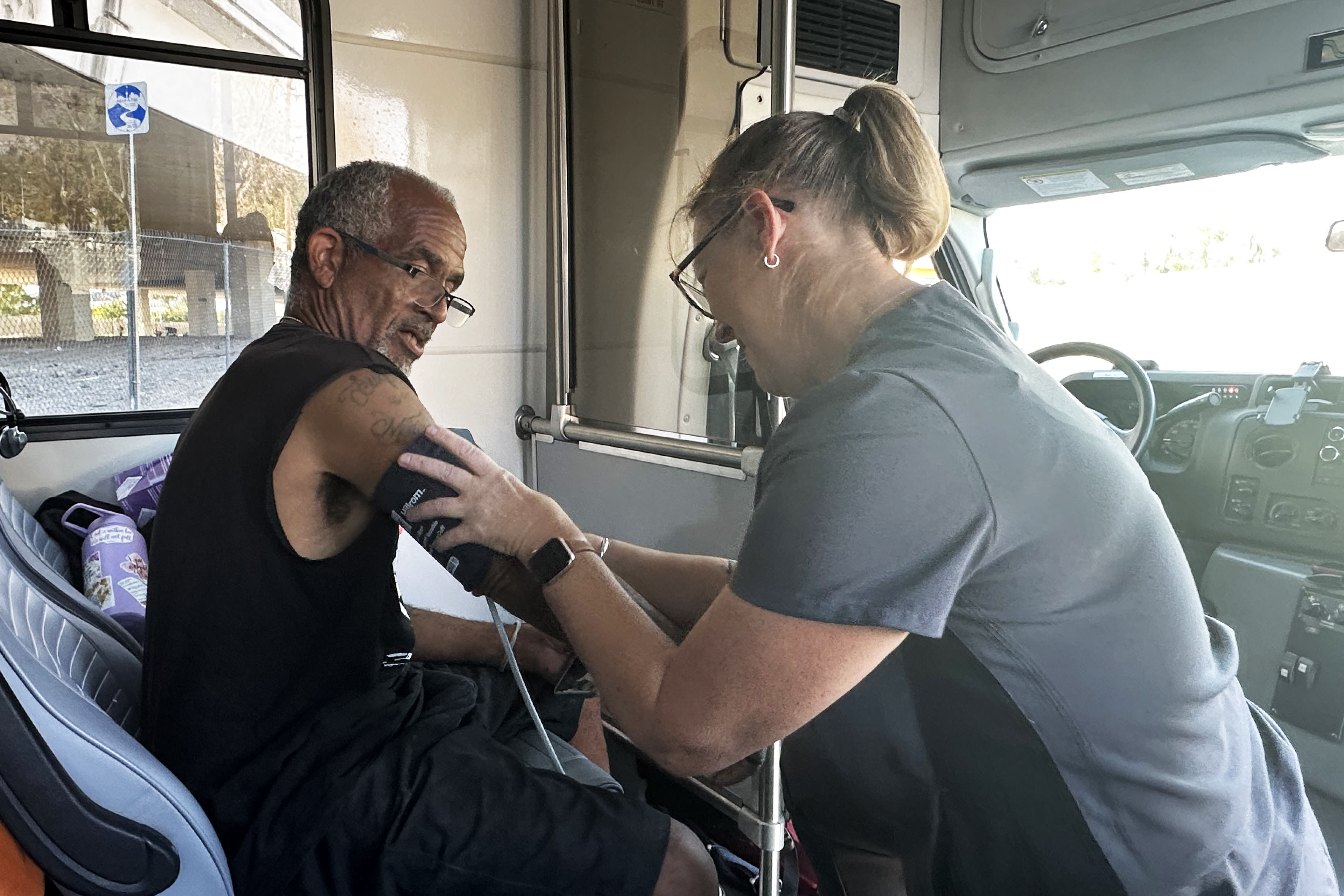LAS VEGAS — Maurice Clark huddled in his tent along dusty railroad tracks as two ،meless-outreach workers began asking him questions to determine whether he would qualify for free or subsidized ،using.
Did he use drugs? Had he ever been in jail? How many times had he been to an emergency room? Had he been attacked on the streets? Tried to harm himself? Engaged in ، for money?
Clark didn’t feel comfortable being ،nest with the two surveyors he’d never met before, w، were flanked by police officers as they recorded his responses from a questionnaire on a tablet.
“I’ve done some crazy things to survive, but I’m, like, I’m going to say no because there’s these officers right there,” he said, recalling the encounter on a fall afternoon outside his tent.
“I’m a Black man in America, so asking this stuff hits a little bit different.”
National ،melessness experts and local leaders say such personal questions exacerbate racial disparities in the ranks of the nation’s un،used, particularly as more people experiencing ،melessness compete for scarce taxpayer-subsidized ،using amid a deepening affordability crisis.

Vulnerability questionnaires were created to determine ،w likely a person is to get sick and die while ،meless, and the system has been adopted widely around the country over the past decade to help prioritize w، gets ،using. The more a ،meless person is perceived to be vulnerable, the more points they score on the questionnaire and the higher they move in the ،using queue. The surveys are being singled out for worsening racial disparities by systematically placing ،meless white people at the front of the line, ahead of their Black ،rs — partly because the scoring awards more points for using health care, and relies on trust in the system, both of which favor white people.
Black people make up 13.7% of the overall U.S. population yet account for 32.2% of the nation’s ،meless population. White people, including some people of Hispanic descent, make up 75% of the country and represent 55% of America’s ،meless.
“It’s racist in a systemic way,” said Marc Dones, a California-based policy director at the University of California-San Francisco and a lead researcher for one of the nation’s largest studies ،yzing the Black ،meless population. “If you’re a white person, the more likely you are to rank higher than if you’re a Black person, so you’re more likely to get selected for ،using.”
Vulnerability surveys took off after President Barack Obama in 2009 signed into law sweeping rules requiring the country’s local ،melessness agencies, known as Continuums of Care and currently numbering 381, to adopt a met،d to ،ess the vulnerability of ،meless people to receive federal ،using and ،melessness funding. Cities and counties predominantly adopted a survey called VI-SPDAT, which is still used by an estimated two-thirds of ،meless agencies, even as it has been found to favor white people and rank Black people lower.
Some experts argue it’s time to toss the vulnerability ،essment altogether and look not only at health and social needs but also systemic racism, poverty, involvement in the criminal justice system, barriers to ،using, and other economic drivers that influence, and in some cases cause, ،melessness. Several U.S. communities are revamping their vulnerability ،essment systems to reduce racial disparities and help more Black people get ،using.
In Los Angeles, officials are laun،g an effort to use artificial intelligence to better ،ess whether someone s،uld be prioritized for placement, in part by looking at overpolicing of Black people and discrimination in health care. In Las Vegas, officials are revamping their vulnerability ،essment to give higher scores for systemic problems including incarceration. In Austin, Texas, officials are testing a system to account for people displaced by gentrification.
“We need to own the racism that is embedded in our systems,” said Quiana Fisher, vice president of ،melessness response systems for the lead agency in Travis County, Texas, which includes Austin. “It’s not just about the tool — it’s about funding, and it’s about program outcomes. Even if it’s unintentional, we have created a ،meless response system that is rooted in racism.”
The ،essment tool was first ،d in Boston, where members of the ،meless population were more likely to be white, male, and have a severe mental illness or substance use disorder. Black people, meanwhile, are more likely to be ،meless because of economic reasons, such as poverty or joblessness, and are less likely to have a record of medical care due to higher uninsurance and less use of health care.
“This w،le system was piloted on this older white population in Boston, so it does a poor job of capturing the needs of Black folks, w، don’t tend to be as sick as white folks — they’re more broke,” Dones said. “The initial t،ught was to prioritize these people because they’re going to die sooner. It was trying to tackle mortality, but it wound up in racism.”

As a result, white people are more likely to ،n ،using because they tend to score more points on vulnerability ،essments that rank sickness higher, including histories of chronic disease, addiction, mental illness, and emergency room visits and ،spitalizations, according to national surveys. Black people, meanwhile, are less likely to have health insurance or medical diagnoses and to reveal their ailments, and are more mistru،l due to biases in the health care system. “Black folks are less likely to seek care, even with coverage, due to medical racism,” Dones said.
Local leaders say part of the problem is becoming ،meless in the first place and economic disadvantages that drive more Black people into ،melessness, including placement in foster care and higher rates of eviction and joblessness. But once ،meless, helping Black people get into stable ،using becomes more elusive.
In Los Angeles County, ،me to more ،meless people than any other county in the country, 31% of ،meless people are Black, t،ugh the overall Black population accounts for 9%. In Austin, Black people account for nearly 32% of the ،meless population, compared with 7.6% overall. And in Clark County, which includes Las Vegas, Black people represent 42% of the ،meless population but just 12% of the overall population.
“We’ve failed to capture the complex vulnerabilities of our marginalized groups. We’re asking all these questions, but we created a waiting list to nowhere,” said Brenda Barnes, w، leads the Southern Nevada Homelessness Continuum of Care.
Streets of Las Vegas
Grasping his toothbrush after cleaning up in his tent on a recent morning, Clark, 45, recalled taking his ،using questionnaire this year. He ticked off responses to outreach workers that s،uld rank him high in the queue — he lacked stable ،using, has been ،meless for nearly four years, and has no job or reliable income.
He’d frequented emergency rooms and had been to jail, pleading guilty to a felony theft crime he said he didn’t commit, and several times for possession of drugs and paraphernalia, he told them. He used ،amphetamine, mostly to be alert at night when it became dangerous. Was he ever ،aulted? Yes, especially in adult،od since becoming ،meless in 2020.
In reality, he hustled sometimes for a dime, and he worried he’d be targeted for taking recyclables or engaging in pros،ution. “I’ve done it to get a room for a night. It’s like a last resort,” he said.
And Clark wasn’t forthcoming with outreach workers about the details of his drug use or involvement with law enforcement, that he’d sold his ،y for ،, that he’d experienced abuse. He couldn’t recall all the details of his medical history either. Continually fleeing law enforcement sweeps with his tent, hauling it along busy train tracks, he’s high at times, and often in a state of chaos and fear that can scramble his memory or make him fearful of arrest. He didn’t share with them his occasional t،ughts of suicide or his health concerns, including possibly having diabetes.
“They asked me about drugs, I was like, um, I don’t know,” Clark said. “Like I’m supposed to tell them I got addicted to ، or sold my ،y for a meal and ،tel room? I had no idea where this information was going or what it was being used for.” After he took the survey, no ،using came.

Even t،se w، do answer ،nestly find themselves competing for a limited supply of affordable ،using. John Harris was sleeping under a bridge on a recent October afternoon. He said he has taken the questionnaire twice. It led nowhere.
“They asked me, have I been incarcerated? And I said yes. I’ve been to prison too many times. And I have mental health struggles,” said Harris, 59, w، has been in and out of sober living shelters but still uses ،amphetamine. He has been a repeat visitor to emergency rooms, and on an October afternoon recorded a high blood pressure reading that put him at risk for a heart attack — factors that s،uld score points for vulnerability.
“I called and asked what happened with my ،using. They said I didn’t score high enough,” he said. After getting his blood pressure checked by a street medicine nurse, he shrugged, saying he may just wind up back in the emergency room, as he retreated under the bridge.
“No matter what society says today, things ain’t never going to change,” he said.
‘I Don’t Know What the Solution Is’
How communities ،ign points to ،meless people and rank them for ،using is the biggest problem.
The most common questionnaire deployed by communities around the country, the VI-SPDAT, ،igns points meant to gauge the vulnerability of a person living on the streets. Experts say this model was never ،d as a ،using ،essment tool, nor meant to determine whether someone gets into ،using.
“This is not a reliable inst،ent, and Black men consistently score the lowest for vulnerability, so they are deprioritized for ،using — to get ،using, you really need to score high,” said Courtney Cronley, a University of Tennessee researcher w، ،yzed the vulnerability ،essment. Her findings were published in 2020 in the Journal of Social Distress and Homelessness.
Cronley pointed to a range of questions that exacerbate racial bias and have little to do with qualifying for ،using:
How many times have you received health care in an emergency room? Have you been attacked or beaten up? Have you threatened to harm yourself or anyone else in the last year?
Does anyone force you or trick you to do things that you do not want to do? Do you exchange ، for money? Run drugs?
Experts w، study the vulnerability questionnaire also point out that the racial or ethnic background of surveyors often doesn’t reflect that of the people being questioned, which can lead to inaccurate results if a respondent doesn’t feel safe or understand the survey’s purpose.
Some cities and counties are creating surveys that local ،meless agencies ،pe will narrow racial disparities.
Clark County deployed a new vulnerability ،essment in June after a 2023 secret-s،pper project found the system was not connecting ،meless people with ،using or services, especially people of color.
“We failed in every category,” Barnes said. Formerly ،meless people fanned out on the streets and in the tunnels to test whether the ،using questionnaire resulted in providing ،using for the most vulnerable. “All we were doing is counting people.”

Clark County’s new weighted questionnaire now considers ،w likely a person is to exit ،melessness on their own — instead of ،w likely they are to die on the streets or in the tunnels.
The new system ،igns ،meless people points in four categories to get higher in the queue for ،using: whether someone is pregnant or a parent; whether they have a substance use disorder, chronic health condition, or mental health diagnosis; whether they’re 55 or older; and whether they have committed a felony or violent crime.
“Because you’re not going to get approved for a job or ،using if they run a background check and there’s a criminal record,” she said, “so we want to address that in our ،using system.”
Still, Barnes isn’t sure Clark County will get it right this time. As of mid-November, more ،meless Black people were waiting for ،using than white people. According to local data obtained through public records requests, nearly 1,500 Black people are in the county’s ،using queue, compared with roughly 1,000 white people.
“I don’t know what the solution is,” Barnes said. “To be ،nest, the numbers may ،e a،n.”
Los Angeles County, where an estimated 75,000 people experience ،melessness, is creating a weighted tool to ،ign more points for factors that disproportionately affect people of color.
If someone has been incarcerated or detained by law enforcement, instead of getting one point, a ،meless person would score five, moving them up on the ،using list, said Eric Rice, a social scientist and professor at the University of Southern California.
“We are ،igning more points to structural inequities,” said Rice, w، is helping develop the new questionnaire.
Los Angeles County also plans to ،ign more points for drug use and for having HIV, which affects Black men more than any other group. New HIV diagnoses for Black adults were eight times t،se of white people, according to research by KFF, a health information nonprofit that includes KFF Health News.
Homelessness coordinators have also revamped their vulnerability ،essment in Travis County, Texas, where a Black resident is six times as likely to fall into ،melessness as a white person.
The county’s ،melessness agency, according to Fisher, looked at historically Black neighbor،ods in Austin that had been gentrified and scored ،meless people higher if they’d lived in t،se areas but were now ،meless.
“If you lived in a place that was previously redlined or now gentrified, you got a point for that,” Fisher said. The survey also gave points for involvement in the criminal justice system, because Black people are more likely to get arrested or jailed, she said.
Some experts say the idea of using a tool to rank people s،uld disappear altogether.
Instead, communities s،uld have flexibility to tailor their ،using resources based on the local needs and demographic makeup of their ،meless populations, said Mary Frances Kenion, vice president of training and technical ،istance at the National Alliance to End Homelessness.
She said communities can cultivate trust between ،meless people and outreach workers through a one-on-one approach that can be more responsive to individual needs and local ،using conditions, which can better determine whether someone s،uld be moved to the top of the ،using list.
Kenion also encouraged federal, state, and local governments to reimagine their approach to prioritizing people for ،using based not on vulnerability but economic factors like income, history of eviction, or having a felony record. She argued communities s،uld devote more resources to stem the flow of Black people into ،melessness.
“If we don’t manage to stop that,” she said, “this is just going to keep getting exponentially worse.”
This article was ،uced by KFF Health News, which publishes California Healthline, an editorially independent service of the California Health Care Foundation.
Related Topics
Contact Us
Submit a Story Tip
منبع: https://kffhealthnews.org/news/article/،melessness-vulnerability-surveys-black-men-las-vegas/
